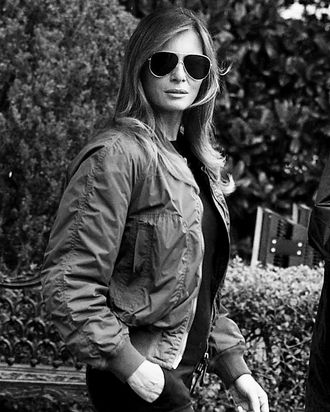
Yesterday, heated debate over Melania Trump’s travel attire nearly overshadowed the very purpose of her trip: to bear witness to the devastation of the Houston hurricane. At stake was whether Melania’s look — slim black pants, face-framing blowout, green silk bomber, mirrored aviators, and sky-high snakeskin stilettos — was appropriately sober and practical for communing with victims of biblical-level flooding.
Those shoes especially drew critical fire. “Melania is wearing stilettos to a hurricane zone,” tweeted a Wall Street Journal reporter. “Trump is the kind of woman who refuses to pretend that her feet will, at any point, ever be immersed in cold, muddy, bacteria-infested Texas water,” observed the Washington Post. Some rushed to defend the First Lady, wielding the usual claim that women’s fashion should be beneath our notice. “I don’t know why anyone should care what anyone wears when they’re on their way to help people,” declared Trevor Noah on his show.
But there is more going on here, and it’s being ignored by detractors and defenders alike. The problem is not that Melania Trump wore an unsuitable, blithely out-of-touch outfit, although she did. The problem is that this administration turns every event — no matter how dire — into a kind of anesthetized luxury fashion shoot, which leads us to some disturbing political truths.
Fashion-magazine layouts have a particular feel to them. We know it well: stylized, blank, alluring in an anonymous way, suggestive of sex, but devoid of sensuality or personal emotion. The photographs draw us in, but the models don’t return our gaze. Instead, they tend to wear a kind of frozen, faraway gaze, a look that frees us to gawk unashamedly, without fear of being caught staring. Fashion models feign ignorance of the camera lens in order to signal that we are not their interlocutors, but rather voyeurs whose desires are roused only to be rechanneled toward the items for sale (clothes, jewels, handbags, etc.).
Such photos exist to cast the fetishizing spell of the commodity over us. They create, that is, a dissociative relationship with the viewer. And while Melania Trump was known to have been somewhat stiff as a model, she has clearly mastered that squinty, middle-distance gaze, which she regularly employs as First Lady.
Melania dresses and moves as if she were awkwardly performing a theatrical role, much as Ivanka does. Their oddly stilted presence in political settings seems to transform all occasions, no matter how “presidential,” into advertisements. This is not because they were both once models, but because they cannot stop posing like models. (Ironically, successful models learn to avoid such obvious artificiality, since it makes the unreality of fashion shoots too glaring.)
The Trump women evince a dazed blankness and anonymity that in turn cast doubt on the reality of everything around them. When you see Melania headed to Marine One, or dining with world leaders, or standing on a White House balcony, the entire scene looks like a magazine spread in which “real” people, equipment, and buildings are being used merely as dramatic backdrops for a fashion layout. On Tuesday, this meant that instead of being a supporting presence in the president’s trip to survey flood damage, Melania became the star and the trip morphed into a simulacrum, a kind of Vogue shoot “simulating” a president’s trip. In other words, the realness of everyone and everything else (including hurricane victims) faded and the evacuated blankness of the commercial overtook the scene.
And this is how something as apparently trivial as women’s style reveals a profound truth at the heart of this administration and its relationship to America’s citizens: It is as dissociative as a fashion advertisement, brought to power by manipulating and rechanneling the electorate’s desires for wealth and possessions. This truth seeps out of every photographed occasion, including and especially those featuring the Trump women.
So Melania dominated the scene yesterday (witness how much we were talking about her), but it was not with her personality. Rather it was the power of the commodity that she wielded — the power of transactional commerce purveyed with utter irreality and disconnection, which it has been her role to channel, and which feels disturbingly recognizable to us in our commerce-saturated society.
Driving that home, Melania actually later donned, somewhat heartbreakingly, a black cap with FLOTUS emblazoned on it — not “America,” or the awful “MAGA,” or her name, or the name of the devastated city she was visiting, or that of a sports team, or even a worthy organization she could have supported, such as the Red Cross. No, Melania wore a hat with the acronym of her role written on it. A non-person-specific hat, making clear that she is just a temporary occupant of this role. She labeled herself.
That’s what models — and in this case also presidents — do: They inhabit anonymously temporary, unreal worlds born of the realm of luxury logo goods. The devastation in Houston is a tragedy, but so too is this administration’s blank, model’s stare — its mirrored shades in the face of human sorrows. This is not just about fashion. It’s about the urgency of recognizing a certain genre of hypnotizing, dehumanizing spell, and snapping ourselves out of it.
Rhonda Garelick is the author of Mademoiselle: Coco Chanel and the Pulse of History.




